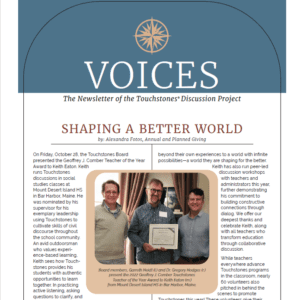
Starting in the fall of 2020, I was very fortunate to begin participating in the Exploring American Perspectives (EAP) Leadership program led by Howard Zeiderman. As our group progressed, I began to see how the EAP program, implemented under Howard’s leadership, positioned us to think reflexively about ourselves, our experiences, and our own involvement with the group and with each other. I was intrigued to find that group introspection, growth, and awareness occurred through and together with our collective consideration of the writings and voices that we read together.
Each week I gained a new appreciation for how a group can come to work together to shed light on inherited perspectives and beliefs from a variety of vantage points. Whereas my tendency had been, at the outset, to gravitate towards “just the text,” it became increasingly clear that text, process, and group experience—through their dynamic interplay—are mutually enriching and inseparable. This interplay, I think, creates a space where central issues can be made visible and animated precisely through the group interaction.
As I continued to be involved with Touchstones and EAP, this time as a co-leader with Stefanie Takacs, whose example, approach, and advice regarding leadership continue to be an invaluable source of understanding for me, I have become more sensitive to the group process. I more fully recognize how different ways of speaking, framing, and interacting operate to change how and what we consider, reflect upon, and engage with collectively.
The first lesson I ran as a co-leader was equal parts nerve-wracking and exhilarating. I found myself on high alert, simultaneously tracking the time, the objectives for the lesson, the group history, how the group was reacting in the moment, and my responsibilities as a leader in light of all those variables. In the back of my mind was also the guiding voice of my own sensibility and instinct for what the next step should be, which came in to punctuate and synthesize my sprawling thoughts and direct a conclusive action.
Spending time considering how each component of the Touchstones lesson fits together and thinking about the needs of the group from week to week, I see connections between the individual work, the small group work, the discussion and the evaluation that I was not fully aware of as a participant. These realizations inform my understanding of what factors change the shape of the group’s interaction towards new opportunities. I’m more sensitive to the kinds of listening that can be taking place in the group. And I’m more attuned to the fact that comments, reactions, even offhand remarks that seem to go in passing or are not met with immediate and direct reply, nonetheless create the background. They shape the conversational space that informs what is immediate and accessible to the group as the interaction unfolds. As we progress, it continues to be great to see the sense of shared leadership, trust, support, and capacity for mutual recognition present within the group, and I look forward to what is ahead on this shared enterprise together.



 Join the
Join the